I thought I was watching chaos.
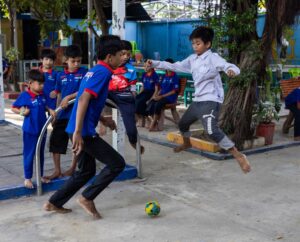
The school day at The Rice Academy of the Cambodian Children’s Fund in Phnom Penh is divided into three morning classes and three afternoon classes of 50 minutes each, punctuated by two ten-minute recess periods and a three-hour lunch break from 11 to 2. For the first few days after I started work as an assistant teacher, I observed everything closely in an attempt to understand the workings of the Academy, its students, and their teachers. It was the activity during the recess periods that initially struck me as chaotic. One hundred adolescent girls and boys unleashed in a boisterous explosion of energy after 50 minutes of math, Khmer, or English.
But as the days went by and I paid close attention to the activity, I began to discover patterns, which blossomed into an understanding of organically organized games and sports. The reasons I had mistaken them for chaotic outbursts were the lack of adult leadership, the absence of elaborate equipment including uniforms and protective devices, and the presence of subtle forms of organization. Eventually I was able to catalog a number of sports and games that were organized entirely by the students. As I watched these games I realized that these students were exercising superpowers: they are athletic, strong, tireless, collaborative, fair, agile, and good-humored.
There are plenty of impediments and obstacles to engaging in sporting events at The Rice Academy. The surface of the entire campus (except for the community garden) is concrete. Much of the concrete is covered with 2’x 2’ rubber pads, but the pads are thin and hardened. There is a covered area which serves as an assembly hall, soccer pitch, and basketball court, but there is no soccer goal and the single basketball rim is bent at an angle that even pushing with all my strength would not return to horizontal. In other words, the children are left to their own devices, although they do have access to every inch of the campus and the road that runs through its middle. It looks something like this:
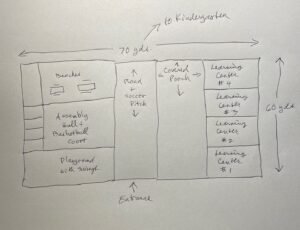
One of the most popular sports is soccer. This sport is usually played by the boys, and almost always takes place in the road that runs down the middle of the campus. The boys divide into teams, and two of them are chosen as goalies. The action takes place within the boundaries of the road, and is fast and furious. The ball is smaller than a regulation soccer ball, and is not inflatable. A lot of energy is put into the play, which does not seem to have a winning side and a losing side. It is as much an artistic as a sporting event. Everybody has a good time, and nobody gets angry or complains about violations of the rules. Everybody knows who Messi and Mbappé are, and mimic them accordingly. One of the most surprising features of the action is that, while many players fall down on the road (which is not padded), I never saw anybody get injured or suffer a wound that bled. I like to watch the goalies, who are in my view the most athletically talented. As the photos above and below demonstrate, the players have both intensity and athleticism.
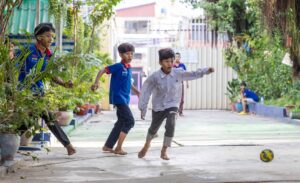
While the boys are doing battle in the road, I frequently spotted the girls engaging in a variety of games under the roof in front of the classrooms. The most interesting to me was a form of high jump that I had never seen before. In Cambodian society, knees and shoulders are meant to be covered, and many of the girls wore long skirts that stretched to their ankles. And yet, these same girls with long skirts participated in high jump contests that involved a special kind of leap and kick that, surprisingly, carried them over a string that is stretched at varying heights between two classmates.
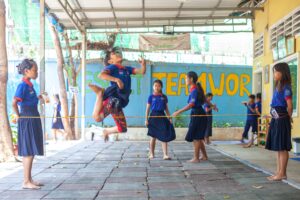
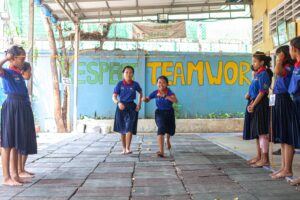
A coeducational game often takes place on the rubber mats in front of the classroom. This is a modified form of a game I played in elementary school that we called dodgeball. In our format, two teams lined up about 25 feet apart. The person who was “it” stood in the middle while the team members took turns throwing an inflated rubber ball at him or her. Whoever hit the “it” took over as the ”it.” You were permitted to remain “it” until you were hit. In the Cambodian version, the teams and format are identical but the weapon was what appeared to me to be a larger-than-usual badminton “birdie.” This game, like soccer and the high jump contests, was organized without debate or rancor. I never saw anybody be “in charge.” It just happened, organically.
My favorite game is called “Chasing the Dragon’s Tail.” There are no teams, and everyone forms into a long conga-like line in which each participant (boys and girls take part) hold on to the shirt of the next person in line. On the count of three, the person at the head of the line sprints forward, and, accordion-like, everybody else follows. The goal is for the head of the dragon to catch the tail. Everyone runs at top speed in a huge circle (I have counted as many as 25 children forming the dragon). Sometimes the head of the dragon catches the tail. Other times the dragon dismembers itself into peals of laughter. This is truly a fun game, with no winners or losers. It is just an exuberant dash around the assembly hall/basketball court. These photos capture only brief, blurry brief moments in the chase, which lasts no more than 15 seconds before chaos takes over and almost everybody falls down, giggling out of control.
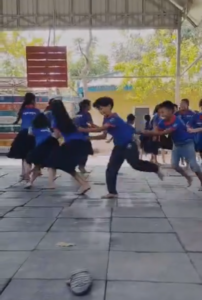
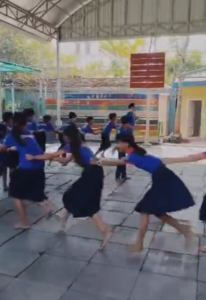
Jump rope is popular with the girls, and I did not see a boy participate. Sometimes the jumping is individual, and the girl holds the rope and jumps over it. Other times the jumping is over a rope that is held by two girls and the jumper navigates over the twirling of the rope. A variation of jump roping is when the jump rope is tied around one ankle and twirled while the alternate foot jumps to avoid the twirling rope. This is quite challenging since it involves both horizontal and vertical movements that must be coordinated. There are several girls at The Rice Academy who are quite proficient at this jump rope variation. I perceive a future for these talented girls as gymnasts.
This is just a sample. The imaginations of the students are unlimited, and I have seen new games (or at least one’s I have not catalogued before) on a weekly basis. My conclusion is that these kids enjoy life, have limitless energy, know instinctively how to collaborate, do not lament a lack of equipment, and engage in healthy, boisterous exercise whenever they have the opportunity. They all exercise their superpowers during recess. Everything I see and learn about the students of the Cambodian Children’s Fund makes me optimistic about their future and the positive impacts they will have on the Kingdom of Cambodia in the coming years.


